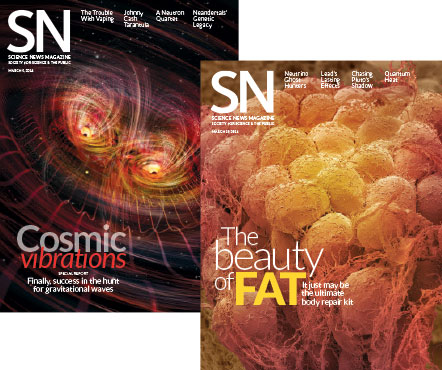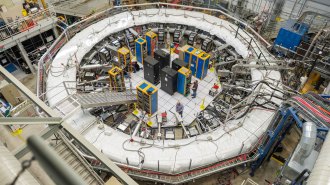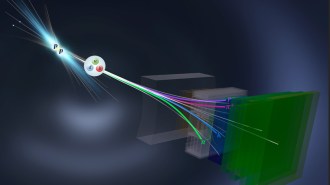Readers ponder gravity wave physics
Reader feedback from the May 14, 2016, issue of Science News
 Gaga for gravity waves
Gaga for gravity waves
With a single chirp, scientists confirmed the existence of gravitational waves created by the collision of two black holes. Science News’ special report (SN: 3/5/16) and subsequent stories in the March 19 issue sparked a flurry of reader questions on the physics of gravitational waves.
Reader Peter Toot wondered if gravitational waves’ ability to bend spacetime stretches light waves. “It seems to me that the expansion and contraction effects of the waves on the [LIGO] detector and surroundings would also apply equally to the wavelength of the light beams used by the detector,” Toot wrote. “If so, it then seems like the impact on phase difference between the recombinant beams would net out to zero phase shift. That clearly didn’t happen. Why not?”
It’s true that gravitational waves affect both the LIGO observatory and the laser light. However, the interferrometer contains two perpendicular arms, says Tom Siegfried. While one arm is shortened by the wave, the other is lengthened. Since the speed of light remains the same in both arms, the change in arm lengths means the two laser beams will not arrive at the same time. Because of this setup, the change in the light’s wavelength is irrelevant.
In his article on the power generated by the black holes’ collision (SN: 3/19/16, p. 5), Christopher Crockett reported that three suns’ worth of mass transformed into gravitational wave energy as the black holes merged. “Was this mass converted to energy or was it momentum (already energy) transferred into a radiating spacetime wave?” asked Ron Blachman. “In any event, the mind reels…. Entropy’ll get us all.”
It appears that the mass was turned directly into energy, Crockett says. LIGO researchers estimated the black holes’ masses before and after the collision. “The energy that came out is roughly what you would expect from that much mass transforming into wave energy,” he said. “The mind does, indeed, reel.”
Fascinating fat
Researchers worldwide are attempting to use stem cells from discarded fat to repair body parts damaged by injury, disease and age, Susan Gaidos reported in “Fat as a fixer” (SN: 3/19/16, p. 22). Clinical studies are currently under way to test these stem cells as potential treatments for chronic obstructive pulmonary disease, type 1 diabetes and other conditions.
In the case of COPD, Harry Walker wondered how stem cells know to target lungs and what potential side effects might be.
When stem cells are injected back into the body through a vein, they go directly to the heart and then travel to the lungs. “Results from studies have shown that once stem cells are directed into the lungs, the cells become ‘trapped,’ ” Gaidos says. “This sounds scary, but the presence of stem cells in the lungs has been shown to have an anti-inflammatory effect and can help regenerate damaged lung tissue.”
Editor’s note
Thomas Sumner’s feature “Mystery at the center of the Earth,” (SN: 9/19/15, p. 18) explored the scientific debate over the mechanisms that power Earth’s magnetic field. Over the last few years, multiple research teams reported that iron conductivity in the planet’s interior is much higher than once thought, creating a paradox concerning the strength of the early Earth’s magnetic field.
On April 13, 2016, researchers retracted a study in Nature featured in the article. Computer simulations by Peng Zhang and colleagues suggested that the electrons responsible for ferrying heat crash into one another and reduce the iron’s conductivity. After other scientists failed to reproduce these results, the team discovered that the initial simulations contained an error.
Revised calculations suggest that electron-electron scattering is not significant to the resistivity of iron in the Earth’s core. This revision supports the high iron conductivities proposed by other groups. The paradox remains.








